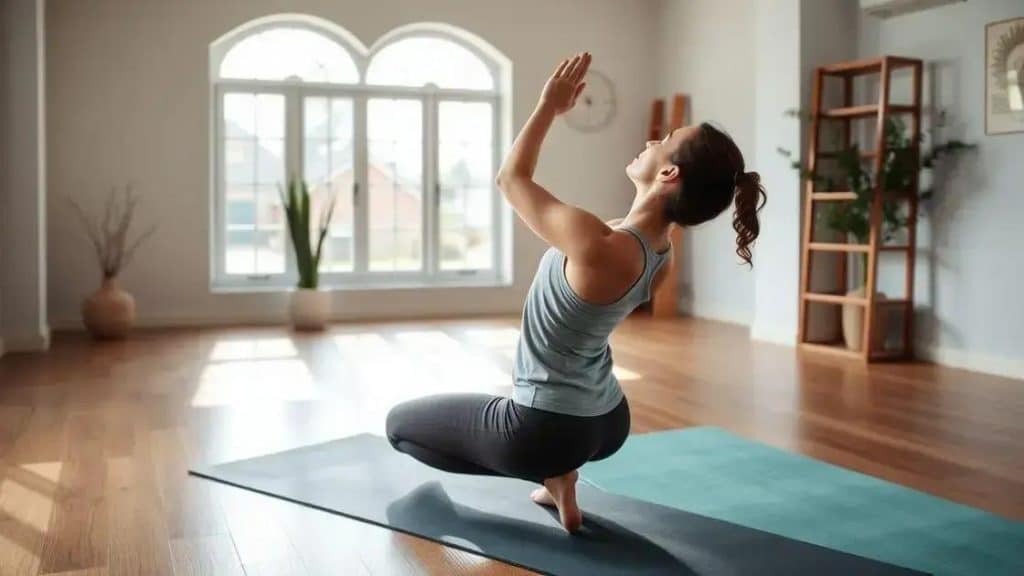Yin yoga poses for emotional release: find your peace

Yin yoga poses for emotional release focus on deep stretching and mindfulness, helping practitioners release pent-up emotions and enhance relaxation through lengthy, restorative holds.
Yin yoga poses for emotional release offer a gentle way to connect with your emotions and find peace. Have you ever noticed how your body holds onto stress? In this article, we’ll explore poses that help release those tensions.
Understanding yin yoga and its benefits
Understanding yin yoga is essential for anyone looking to find deeper emotional and physical relaxation. Yin yoga is a gentle and restorative practice that targets the body’s connective tissues and enhances overall well-being. By holding postures for longer periods, you allow both your mind and body to release tension.
The core concepts of yin yoga
Yin yoga differs from other styles because it focuses on slowing down and holding poses, often for three to five minutes. This approach allows for deeper stretching and can improve flexibility. Not only does it relieve physical tension, but it also supports emotional release.
Benefits of practicing yin yoga
- Increased flexibility: Regular practice helps in loosening tight joints and muscles.
- Emotional release: Yin yoga can aid in processing emotions and reducing anxiety.
- Enhanced relaxation: It promotes a state of calmness, reducing stress levels.
- Mindfulness development: It encourages a deeper connection with the self through meditation.
Through this mindful practice, you can foster a better connection with your emotions, learning to accept and embrace them. Incorporating yin yoga into your routine can lead to profound changes in your mental and emotional state.
As you explore deeper poses, you might notice how the time spent in stillness can shift your perspective and allow you to let go of pent-up energy. Whether you are new to yoga or have practice experience, understanding yin yoga will enhance your emotional well-being.
Top poses for emotional release

When practicing yin yoga, certain poses are particularly effective for emotional release. These poses not only stretch the body but also help in clearing emotional blockages. Engaging in these specific postures can lead to a profound sense of relaxation and balance.
Key yin yoga poses for emotional release
Here are some essential poses that you can incorporate into your practice:
- Child’s Pose: A gentle pose that calms the mind, providing a safe space to connect with feelings.
- Butterfly Pose: This opens the hips and allows for a deeper release of pent-up emotions.
- Reclining Bound Angle Pose: Helps in releasing emotional tension stored in the lower body.
- Dragon Pose: Targets the hips and groin, facilitating emotional release through deep stretching.
As you flow through these poses, pay attention to any sensations that arise. Many practitioners find it beneficial to focus on their breath while holding the poses, as deep breathing can enhance emotional processing. Allow yourself to be present and let go of any judgments or expectations.
In addition to these specific poses, exploring variations can also lead to greater emotional release. Each body is different, and finding what works best for you is key. Take your time in each posture, allowing your body to soften and release tension as you breathe deeply.
The beauty of yin yoga is its ability to connect the mind, body, and emotions. By intentionally practicing these poses, you pave the way for a journey of self-discovery and emotional clarity.
How to create a yin yoga practice
Creating a yin yoga practice involves understanding your body’s needs and setting a calming environment. Yin yoga is all about slow movements, deep stretches, and holding poses for longer periods. This approach makes your practice effective for emotional release and overall well-being.
Steps to start your yin yoga practice
First, choose a peaceful space where you feel comfortable and relaxed. Make sure you have your yoga mat, some cushions or blankets, and possibly a few props like blocks. Lighting candles or playing soft music can enhance the atmosphere.
Establishing a routine
Consistency is key in any yoga practice. Aim to practice yin yoga at least two to three times a week. Start with 20 to 30 minutes, gradually increasing the time as you become more comfortable with the poses. You might also consider incorporating a few minutes of meditation before starting.
Common yin yoga poses
- Child’s Pose: Perfect for calming the mind.
- Half Butterfly: Ideal for opening the hips gently.
- Caterpillar Pose: Targets the spine and hamstrings.
- Sphinx Pose: Strengthens the lower back.
As you hold each pose, focus on your breath and allow yourself to sink deeper into the stretch. Listen to your body; if a pose feels uncomfortable, adjust or skip it. The goal is to promote relaxation and emotional healing, not pain.
Remember, it’s essential to check in with yourself throughout your practice. Allow any emotions to surface and simply observe them without judgment. Creating a yin yoga practice that resonates with you can transform your emotional landscape.
Tips for maximizing your yin yoga experience

Maximizing your yin yoga experience can transform your practice into a powerful tool for emotional and physical healing. By focusing on a few key elements, you can deepen your engagement and enhance the benefits of each session.
Create a calm environment
Transform your practice space into a sanctuary. Use soft lighting, like candles or lamps, to create warmth. Aromatherapy can also enhance your experience; consider using essential oils like lavender or eucalyptus to soothe your senses.
Focus on your breath
Your breath is a powerful tool during your practice. As you move into each posture, pay attention to your inhalations and exhalations. Deep breathing helps release tension and invites relaxation. Think of your breath as a gentle wave, guiding you through each pose.
Listen to your body
Every body is unique, and it’s essential to honor your limits. When practicing yin yoga, focus on how each pose feels rather than achieving perfection. If something feels uncomfortable, modify or skip the pose. The goal is to find what works for you.
Practice mindfulness
- Stay present: Keep your mind focused on the sensations and emotions arising during your practice.
- Let go of judgments: Accept your practice as it is without self-criticism.
- Embrace your emotions: Allow feelings to surface; this is part of the healing process.
Incorporating these tips into your practice can enhance the overall experience and support your emotional release. Remember, yin yoga is not just about physical poses; it’s about creating a deep connection between your mind and body. Take your time in each pose, breathe deeply, and enjoy the journey.
FAQ – Frequently Asked Questions about Yin Yoga
What is yin yoga?
Yin yoga is a slow-paced style of yoga that involves holding poses for longer periods to target the body’s connective tissues and promote relaxation.
How can yin yoga help with emotional release?
Yin yoga helps release stored emotions by encouraging deep stretching and mindfulness, allowing practitioners to process feelings that arise during practice.
How often should I practice yin yoga?
It’s recommended to practice yin yoga at least two to three times a week to experience its full benefits for relaxation and emotional balance.
Do I need special equipment for yin yoga?
Basic yoga equipment such as a yoga mat is essential. Props like cushions, blocks, and blankets can enhance your practice by providing support and comfort.





